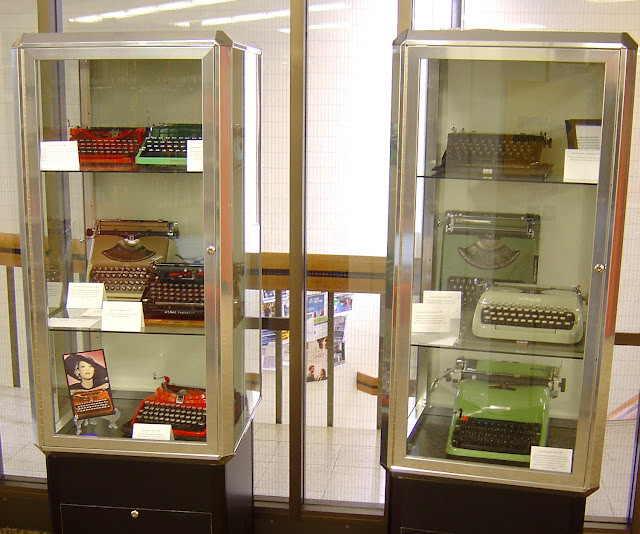The final installment in my display at the Xavier University library is intended to introduce viewers to modern portables, unusual keyboards and typefaces, and last but not least, pretty colors.

Corona Four (USA, 1928): The successor to the Corona 3, which had a folding carriage, this model has a four-row keyboard and non-folding carriage but is still quite compact. Corona merged with L.C. Smith, a maker of office typewriters, to form Smith-Corona in 1926. The company manufactured typewriters into the twenty-first century, but today produces only thermal labels and tape.
Remington Noiseless Portable (USA, 1933): “Noiseless” typewriters, which soften the impact of the typebars against the platen, were popular in the 1930s and 1940s. This two-tone green model was a deluxe version that sold in small numbers during the Depression.
Groma Kolibri (East Germany, ca. 1960): The Kolibri (“Hummingbird”) is a well-made East German ultraportable. This one has a Greek keyboard and is also capable of typing in capital Roman letters. A Groma Kolibri plays a prominent role in the 2006 film “The Lives of Others.”
Merz no. 2 (Germany, ca. 1927): This portable from a smaller German manufacturer features a Bulgarian keyboard.
Olivetti MP1 (Italy, 1938): The leading Italian typewriter manufacturer, Olivetti was known for its innovative styling. Its first portable model is a good example of Art Deco design.
Adler Favorit no. 2 (Germany, 1939): This large portable uses a thrust-action system in which typebars slide horizontally to the platen. [When I installed this typewriter I realized it was a poor choice. It is hard to appreciate on a top shelf with poor lighting. No going back, though -- my selections had to be listed in advance so they could be insured specifically by make, model, and serial number. If I could pick a new one it might be the little
Junior 58 from Spain.]
Rooy portable (France, 1953): This ingenious, ultrathin “laptop” typewriter is permanently attached to a case that serves as a base when the machine is in use.
Continental (East Germany, ca. 1955): Usually labeled Erika 10, this socialist product was named Continental when it was sold with an Arabic keyboard. In order to write Arabic, the machine types from right to left and uses proportional spacing.
Olivetti Graphika (Italy, 1958): This machine employs proportional spacing, assigning different widths to different characters (an M takes up more width than an i, for example). A special typeface was created for it by designer A. M. Cassandre. Relatively slow and difficult to use, the Graphika was not a market success.







